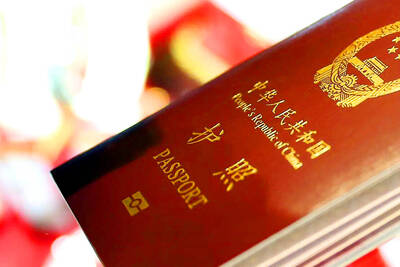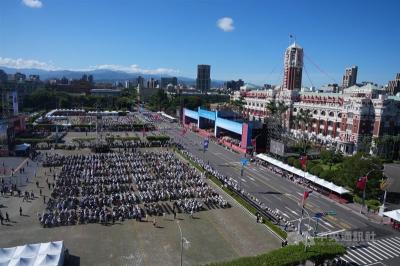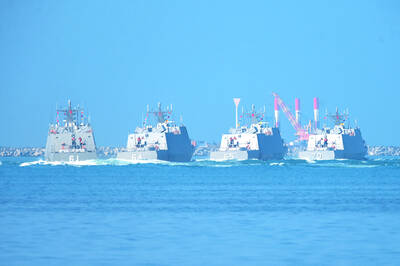Amid all the economic gloom, one business is still booming — India’s mobile phones — thanks to the world’s lowest call rates driven by fierce competition among cellular operators, experts said.
And while economists forecast a sharp slowdown in India’s economic growth, no downturn is seen in the mobile market, which added a record 15.4 million wireless users in January — the biggest monthly growth ever, the latest official data showed.
“India represents a unique mobile market where competition is the highest and the tariffs are the lowest,” said T.V. Ramachandran, head of the Cellular Operators Association of India.

PHOTO : AFP
And it’s not just affluent Indians who are buying phones in the world’s fastest growing cellular market — India outstripped China last April.
Most of the growth has been driven by laborers, maids, drivers and other lowly paid people in cities and increasingly in rural areas as innovative marketing has made phoning cheap enough for some of the poorest pockets.
“One of the biggest factors in this growth has been affordability both in terms of handset and tariff plans,” said Girish Trivedi, a senior analyst at consultancy Frost & Sullivan.
Customers can pay less than US$0.02 for a call and US$13 for a new mobile handset. Second-hand ones can cost far less.
For many, mobile phones mean their livelihood.
Sixty-two-year-old house painter Akshaye Jha runs his two-man business in New Delhi from his mobile phone.
“It means people can get in touch with me. I get more jobs,” Jha said.
“The mobile has become a device for the masses ... an agent of change,” transforming ways of communicating and doing business, Ramachandran said.
People are also buying phones even when they don’t need them for work.
Munshi, a security guard, never learned how to read numbers and gets other people to dial. He keeps his handset in his breast pocket and starts with surprise when it rings with a bouncy Hindi pop tune.
“It keeps me in touch with my family in the village,” he smiles after getting a call from a nephew.
In rural areas, meanwhile, people are snapping up phones at an ever quicker pace as mobile firms aggressively roll out networks, sharing costs of infrastructure to reach far-flung areas quickly and cheaply, experts said.
Farmers are using mobile phones to call other farmers to find out the market price for crops like rice, fruit and coconuts.
Market players say tumbling stock markets and property prices are not stopping many poor Indians signing up for phones as they don’t own shares or real estate and are not being hit.
“The people in rural India are not being affected by the global crunch,” Sanjay Gupta, chief marketing officer of Bharti Airtel, India’s leading cellular provider, said in an interview.
India’s “mobile revolution” is still mainly seen in the cities, but the real prize for phone companies is the vast rural market, where nearly 70 percent of the 1.1-billion-strong population live, analysts said.
By the end of January, 34.5 percent of the population owned a telephone, Telecom Regulatory Authority of India said.
But those figures distort the picture, with 66 percent of people in cities owning a phone compared to around 9 percent in rural areas, Frost & Sullivan said.
“The next addition of subscribers will come from rural regions,” Trivedi said.
The government calls the rural market the “next accelerator” for mobile growth.
Total wireless connections stand at 362.30 million, up from 233.63 million a year earlier. Combined with fixed line users, the country now has more than 400 million telephone connections.

The Ministry of the Interior (MOI) is to tighten rules for candidates running for public office, requiring them to declare that they do not hold a Chinese household registration or passport, and that they possess no other foreign citizenship. The requirement was set out in a draft amendment to the Enforcement Rules of the Public Officials Election and Recall Act (公職人員選舉罷免法 ) released by the ministry on Thursday. Under the proposal, candidates would need to make the declaration when submitting their registration forms, which would be published in the official election bulletin. The move follows the removal of several elected officials who were

The Republic of China (ROC) is celebrating its 114th Double Ten National Day today, featuring military parades and a variety of performances and speeches in front of the Presidential Office in Taipei. The Taiwan Taiko Association opened the celebrations with a 100-drummer performance, including young percussionists. As per tradition, an air force Mirage 2000 fighter jet flew over the Presidential Office as a part of the performance. The Honor Guards of the ROC and its marching band also heralded in a military parade. Students from Taichung's Shin Min High School then followed with a colorful performance using floral imagery to represent Taiwan's alternate name

FOUR DESIGNATED AREAS: Notices were issued for live-fire exercises in waters south and northwest of Penghu, northeast of Keelung and west of Kaohsiung, they said The military is planning three major annual exercises across the army, navy and air force this month, with the navy’s “Hai Chiang” (海強, “Sea Strong”) drills running from today through Thursday, the Ministry of National Defense said yesterday. The Hai Chiang exercise, which is to take place in waters surrounding Taiwan, would feature P-3C Orion maritime patrol aircraft and S-70C anti-submarine helicopters, the ministry said, adding that the drills aim to bolster the nation’s offshore defensive capabilities. China has intensified military and psychological pressure against Taiwan, repeatedly sending warplanes and vessels into areas near the nation’s air defense identification zone and across

COVETED PRIZE: The US president would be a peace prize laureate should he persuade Xi Jinping to abandon military aggression against Taiwan, William Lai said US President Donald Trump should get the Nobel Peace Prize should he be able to convince Chinese President Xi Jinping (習近平) to abandon the use of force against Taiwan, President William Lai (賴清德) told a conservative US radio show and podcast in an interview. The US is Taiwan’s most important international backer, despite the absence of formal ties, but since Trump took office earlier this year he has not announced any new arms sales to the nation. Trump could meet Xi at the APEC summit in South Korea on Oct. 31 and Nov. 1. Lai, speaking on The Clay Travis and Buck Sexton